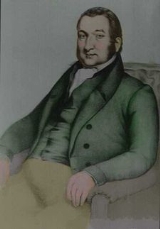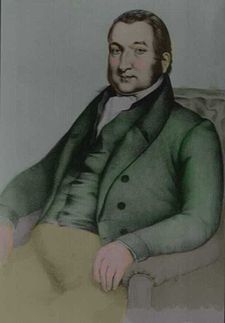
Sir William Charles Ellis
Encyclopedia
Sir William Charles Ellis (1780–1839) was the superintendent of the West Riding Pauper Asylum.

, Lincolnshire
on 10 March 1780. His early career was as an apothecary
but he soon took an interest in the treatment of mental disorders. This he learnt at the Sculcoates Refuge in Hull; which was run on a similar model as the York Retreat
.
In 1817 a William Ellis was appointed as superintendent to the newly built West Riding Pauper Asylum at Wakefield.
A Methodist, he too had strong religious convictions and so with his wife as matron he employed the same principles of humane treatment and moral therapy as practised at Sculcoates Refuge.
After 13 years their reputation had become such, that they were then invited to run the newly built first pauper asylum in Middlesex called the Hanwell Asylum
.
Accepting the posts, the asylum opened in May 1831. Here the Ellis's introduced their own flavour of 'humane treatment' and moral therapy combined with 'therapeutic employment'. The approach he used went down well with patients, it was always voluntary, it made them feel valued and appreciated, it enabled them to recover their self esteem. Also, by having something with real 'purpose' to do that helped with the care of others or help with the running of the asylum, not only occupy their time but also took the minds off their troubles and suicides became extremely rare. By preserving their everyday life skills in this way he made it easier for his patients to pick up their lives again when they were well enough to leave, which now came sooner because these methods speeded recovery.
Ellis became famous in his own lifetime for his pioneering work and his adherence to this 'Great Principle of Therapeutic Employment' and was rewarded with a knighthood.
It may be helpful to point out here that those records that appear to show poorer recovery rates than achieved today, are total patient counts. As the new asylum system grew so the number of those admitted that were always deemed 'incurable' and were quite different from the 'lunatic insane' which is what these institutions for were originally built for. The greater part of these new classes of patients were the elderly, sent by the workhouse
s as being ill and very close to death. Also, before the introduction of antibiotics there were other incurables such as those with tertiary syphilis and gonorrhea
that came in. Towards the end of the nineteenth century, greater numbers of people suffering from epilepsy were also getting admitted. All this had the effect of considerably slewing some of the modern accounts critical of the effectiveness of these early establishments, even though there survives a great mass of comprehensive and detailed records from this period. On top of this, when the NHS
took on the running of the mental hospitals they stopped admitting those classes of patient that appear in the Victorian records as 'idiots,' 'imbeciles' and 'feeble-minded.' These people were now sent to care homes elsewhere.
Ellis resigned his post at Hanwell
in 1838. This came about because the visiting Justices wished to expand the capacity of the asylum again. Also, for such an institution which was wholly funded for by a levy on the local rates, it was becoming of the utmost importants, in the opinion of the visiting justices, that that best use be made of the assets and monies spent, and that there were records and statistics to demonstrate that this was indeed being archived. However, this required an organisational change in the way and in the detail that the asylum was managed and run.
William and his wife Mildred enjoyed a being involved with all aspects of patient care and oversight of staff in order to create a 'domestic' or homely environment (or as is being reinvented today as Nidotherapy).
As Ellis stated that same year:
These intended changes made it impossible for the two of them to continue to do what their heart felt conviction demanded.
He and Lady Ellis then set up their own private asylum for a few ladies and gentlemen of the upper social classes, quite nearby, in the grounds of Southall Park; this being the former residence of Lord Montford.
Alas, Ellis was a very large man and plagued throughout his life by ill health. This no doubt lead to his untimely death from dropsy just as short while later on 24 October 1839.

Biography
He was born in AlfordAlford, Lincolnshire
- Notable residents :* Captain John Smith who lived in nearby Willoughby* Anne Hutchinson, pioneer settler and religious reformer in the United States* Thomas Paine, who was an excise officer in the town....
, Lincolnshire
Lincolnshire
Lincolnshire is a county in the east of England. It borders Norfolk to the south east, Cambridgeshire to the south, Rutland to the south west, Leicestershire and Nottinghamshire to the west, South Yorkshire to the north west, and the East Riding of Yorkshire to the north. It also borders...
on 10 March 1780. His early career was as an apothecary
Apothecary
Apothecary is a historical name for a medical professional who formulates and dispenses materia medica to physicians, surgeons and patients — a role now served by a pharmacist and some caregivers....
but he soon took an interest in the treatment of mental disorders. This he learnt at the Sculcoates Refuge in Hull; which was run on a similar model as the York Retreat
The Retreat
The Retreat, commonly known as the York Retreat, is a place in England for the treatment of people with mental health needs. Located in Lamel Hill in York, it operates as a not for profit charitable organisation....
.
In 1817 a William Ellis was appointed as superintendent to the newly built West Riding Pauper Asylum at Wakefield.
A Methodist, he too had strong religious convictions and so with his wife as matron he employed the same principles of humane treatment and moral therapy as practised at Sculcoates Refuge.
After 13 years their reputation had become such, that they were then invited to run the newly built first pauper asylum in Middlesex called the Hanwell Asylum
Hanwell Asylum
The County Asylum at Hanwell, also known as Hanwell Insane Asylum, and Hanwell Pauper and Lunatic Asylum, was built for the pauper insane and is now the West London Mental Health Trust ...
.
Accepting the posts, the asylum opened in May 1831. Here the Ellis's introduced their own flavour of 'humane treatment' and moral therapy combined with 'therapeutic employment'. The approach he used went down well with patients, it was always voluntary, it made them feel valued and appreciated, it enabled them to recover their self esteem. Also, by having something with real 'purpose' to do that helped with the care of others or help with the running of the asylum, not only occupy their time but also took the minds off their troubles and suicides became extremely rare. By preserving their everyday life skills in this way he made it easier for his patients to pick up their lives again when they were well enough to leave, which now came sooner because these methods speeded recovery.
Ellis became famous in his own lifetime for his pioneering work and his adherence to this 'Great Principle of Therapeutic Employment' and was rewarded with a knighthood.
It may be helpful to point out here that those records that appear to show poorer recovery rates than achieved today, are total patient counts. As the new asylum system grew so the number of those admitted that were always deemed 'incurable' and were quite different from the 'lunatic insane' which is what these institutions for were originally built for. The greater part of these new classes of patients were the elderly, sent by the workhouse
Workhouse
In England and Wales a workhouse, colloquially known as a spike, was a place where those unable to support themselves were offered accommodation and employment...
s as being ill and very close to death. Also, before the introduction of antibiotics there were other incurables such as those with tertiary syphilis and gonorrhea
Gonorrhea
Gonorrhea is a common sexually transmitted infection caused by the bacterium Neisseria gonorrhoeae. The usual symptoms in men are burning with urination and penile discharge. Women, on the other hand, are asymptomatic half the time or have vaginal discharge and pelvic pain...
that came in. Towards the end of the nineteenth century, greater numbers of people suffering from epilepsy were also getting admitted. All this had the effect of considerably slewing some of the modern accounts critical of the effectiveness of these early establishments, even though there survives a great mass of comprehensive and detailed records from this period. On top of this, when the NHS
National Health Service
The National Health Service is the shared name of three of the four publicly funded healthcare systems in the United Kingdom. They provide a comprehensive range of health services, the vast majority of which are free at the point of use to residents of the United Kingdom...
took on the running of the mental hospitals they stopped admitting those classes of patient that appear in the Victorian records as 'idiots,' 'imbeciles' and 'feeble-minded.' These people were now sent to care homes elsewhere.
Ellis resigned his post at Hanwell
Hanwell
Hanwell is a town situated in the London Borough of Ealing in west London, between Ealing and Southall. The motto of Hanwell Urban District Council was Nec Aspera Terrent...
in 1838. This came about because the visiting Justices wished to expand the capacity of the asylum again. Also, for such an institution which was wholly funded for by a levy on the local rates, it was becoming of the utmost importants, in the opinion of the visiting justices, that that best use be made of the assets and monies spent, and that there were records and statistics to demonstrate that this was indeed being archived. However, this required an organisational change in the way and in the detail that the asylum was managed and run.
William and his wife Mildred enjoyed a being involved with all aspects of patient care and oversight of staff in order to create a 'domestic' or homely environment (or as is being reinvented today as Nidotherapy).
As Ellis stated that same year:
These intended changes made it impossible for the two of them to continue to do what their heart felt conviction demanded.
He and Lady Ellis then set up their own private asylum for a few ladies and gentlemen of the upper social classes, quite nearby, in the grounds of Southall Park; this being the former residence of Lord Montford.
Alas, Ellis was a very large man and plagued throughout his life by ill health. This no doubt lead to his untimely death from dropsy just as short while later on 24 October 1839.
Trivia
Benjamin Lambden (age 19), was indicted of stealing one sheep on 30 November 1838. Valued at 25 shillings (₤1 – 25p) which, it was said belonged to William Ellis of Southall Park. He was found guilty and sentenced to be Transported for ten years .External links
- Martineua, Harriet The Hanwell Lunatic Asylum Description of the Ellis system; published in Tait's Edinburgh Magazine. June 1834 Roberts, Andrew (1981)The asylums index. Middlesex University, London, England. Retrieved on 2006-10-07

